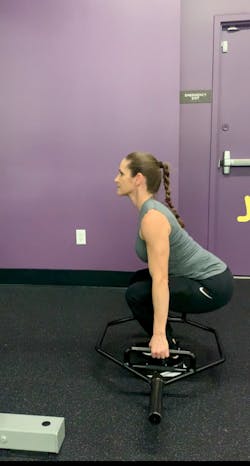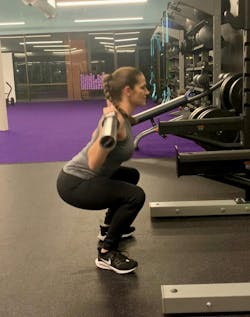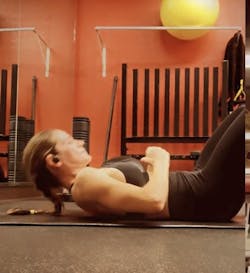Rethinking movement, posture, and ergonomic longevity for hygienists
What you'll learn in this article
- Prolonged static sitting, even in neutral posture, leads to muscle fatigue after just 4.5 hours.
- Alternating between standing and sitting patients improves circulation and reduces joint strain.
- Micro-movements during appointments redistribute load and decrease physical discomfort.
- Strength training builds resilience against forward-flexed clinical work.
- Behavioral ergonomics, not just equipment, determines long-term musculoskeletal health.
Ask any dental hygienist about our working posture, and you’ll hear about magnification, saddle stools, and patient positioning. But what if the real key to ergonomic longevity isn’t posture in the way we’ve traditionally defined it? What if it’s about antistatic neutral movement?
The body is meant to move, and not just from the op to sterilization and back. Movement is needed where we spend most of our time—during practice. The precision sensitive work that we perform creates a dilemma (we can hardly do jumping jacks while probing), but we can certainly learn to overcome it.
Biomechanical studies reveal that ideal posture is not a fixed position, it’s a dynamic behavior.1 In other words, the best posture is the one that’s moving and adjusting in neutral. As dental professionals facing prolonged static positioning and repetitive motions, the concept of postural variability could be the missing link in staying pain-free and productive long-term.
The myth of “perfect posture”
For years, ergonomic guidelines have championed neutral spine alignment, proper seat height, and proper arm positioning as the hallmarks of injury prevention. These cues are important, but the often-overlooked fundamental message is this: holding any position too long, no matter how neutral, leads to fatigue and dysfunction.
Maekawa et al. demonstrated that muscle stiffness and fatigue set in after just 4.5 hours of static sitting, even in a neutral posture with back support and proper alignment.1 This emphasizes that stillness (i.e., fully contracted bodies), not slouching, may be a greater risk factor in musculoskeletal disorders (MSDs).
The power of postural variability
The solution? Movement. Or more specifically, frequent micro-movements that redistribute load across tissues. In a comprehensive review of sit-stand workstations, Davis and Kotowski found that switching positions and incorporating low-intensity movement significantly decreased physical discomfort and fatigue in workers with static jobs.2
Alternating every other patient between sitting (in a saddle) and standing where postural micro shifting occurs, such as shifting foot position or weight distribution during the appointment, can offer the same protective benefits.
Some hygienists also choose to change posture during specific tasks, standing for scaling and sitting for polishing/flossing. Postural variability is the key because it improves circulation, reduces pressure on joints, and interrupts sustained muscle loading, factors that directly reduce risk of neck, back, and shoulder pain.3
Strength is an ergonomic tool
Movement is vital, but without muscular endurance, the body can’t support it. Stuart McGill, a leading spinal biomechanist, underscores the need for a strong core, shoulder girdle, and hips to stabilize the spine under load.4 For hygienists, this means resistance training is no longer optional—it’s our best insurance policy.
Stretching is often the go-to solution for discomfort, but strength builds resilience. A two to three times per week strength building routine targeting the posterior chain (glutes, hamstrings, spinal erectors, trapezius, rhomboids) can offset the forward-flexed nature of clinical work. Even small gains in strength improve postural tolerance and reduce fatigue that seem to snowball as we age.
Examples of such exercises are deadlifts, squats, rows, presses, lunges, and crunches. See Figures 1-4. Figure 3 is above.
Movement habits over quick fixes
In a long-term review of risk factors for MSDs in the neck and upper limbs, Ariëns et al. found that prolonged static postures were significantly associated with neck and shoulder pain in dental and office workers.5 This finding confirms that behavioral ergonomics—how we practice—is at least equally protective as any single product or “fix.” For example, using ergo loupes but holding an arm away from the body during practice will not stop the pain that comes from a chronic chicken wing (abducted arm).
Put it into practice
- Alternate standing and sitting (on a saddle stool) every other patient.
- Use equipment that places the body in neutral (ergo loupes, saddle stools, etc.)
- Consistently perform two to three resistance workouts per week focused on back, core, and glutes.
- Take one-minute microbreaks between patients to stretch, breathe, and reset.
- Do a routine posture check and reset. Mindfulness is key to change.
It’s not just ergonomics, it’s longevity
Ergonomics is about preserving your career. Every movement you make throughout the workday is either contributing to discomfort or protecting you from it. By reframing posture as a behavior, prioritizing variability, and embracing strength training, you can reclaim ownership over your health, comfort, and long-term ability to serve patients.
The science is clear: to stay strong in practice, you have to keep moving.
Editor's note: This article appeared in the November/December 2025 print edition of RDH magazine. Dental hygienists in North America are eligible for a complimentary print subscription. Sign up here.
References
- Maekawa Y, Kaneko S, Goto T, et al. Influence of posture on muscle stiffness during prolonged sitting. Biomechanics. 2021;1(2):217-228. doi:10.3390/biomechanics1020016
- Davis KG, Kotowski SE. The effect of sit-stand workstations on office worker health: a review. Work. 2014;49(4):599-605. doi:10.3233/WOR-131748
- Kumar S. Theories of musculoskeletal injury causation. J Occup Rehabil. 2001;11(1):25-39. doi:10.1023/A:1016631428296
- McGill SM. Low Back Disorders: Evidence-Based Prevention and Rehabilitation. 3rd ed. Human Kinetics; 2015.
- Ariëns GA, Bongers PM, Douwes M, et al. Are neck flexion, neck rotation, and sitting at work risk factors for neck pain? Occup Environ Med. 2001;58(3):200–208. doi:10.1136/oem.58.3.200
About the Author

Katrina Klein, RDH, CEAS, CPT
Katrina is an 18-year registered dental hygienist, national speaker, author, competitive bodybuilder, certified personal trainer, certified ergonomic assessment specialist, and biomechanics nerd. She’s the founder of ErgoFitLife, where she teaches that ergonomics and fitness are a lifestyle to prevent, reduce, and even eliminate workplace pain. You can reach Katrina at [email protected].



